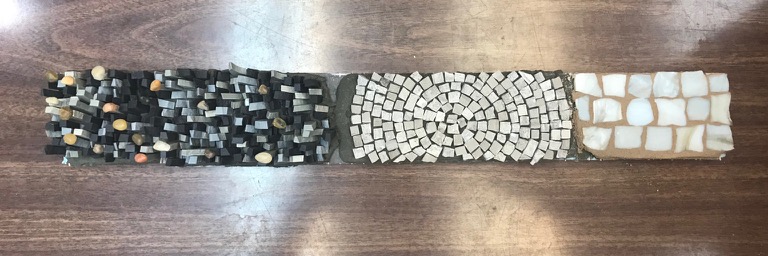Playtime

I am still making the transition back to a ‘professional mosaic studio with cats’ from a ‘cat sanctuary that contains my mosaic tools and supplies’. The road is long, sometimes discouraging, but always entertaining.
Above is a repair project on one of my mom’s terra sigillata pots that had a broken lip. We used super glue to stick the broken part back onto the rest of the lip. But, of course, in the process of being broken, smaller pieces were lost in space, creating a couple of obvious voids along the break-line. My intention was, in the Japanese tradition of kintsugi, to fill in the voids with “gold” in the form of golden metallic dust embedded in the surface of cement grout. Let’s say it was super-hard to get this underway because I couldn’t leave the rather heavy, but tenderly delicate pot on the table unattended long enough to fetch water for the grout.

Above is a sample strip I made using three different materials and techniques to explore materials I already have supplied in my studio. I am quite intent on creating with materials that have a non-machine-made quality and organic edges.
In a previous post I mentioned my response when I cut square porcelain tiles into random shapes and glued them on edge (on end, really)- I was disappointed that the sharp angles and extremely flat surfaces were still prominent. I experimented with modifying the hard quality of the porcelain by gluing pebbles on the flat tops of some of the tesserae.
In the middle sample experiment, I used stone that I cut with my hammer and hardie to make irregularly-shaped tesserae to lay into a circle pattern.
Then, in the third experiment, I took a jar of square vitreous tiles and cut each of the four edges with a wheeled nipper to create non-standard sizes and squarish shapes of glass, which pleases me more at this point than does using the tiles as squares. The surface is reminiscent of mother-of-pearl, or nacre, from a shell.
